![]()
![]()
![]()
Use LEFT and RIGHT arrow keys to navigate between flashcards;
Use UP and DOWN arrow keys to flip the card;
H to show hint;
A reads text to speech;
243 Cards in this Set
- Front
- Back
|
To what kingdom do prokaryotic cells belong to?
|
MONERA
|
|
|
What unique characteristic defines prokaryotic cells?
|
No membrane bound organelles. Genetic material is in "nucleoid" region.
|
|
|
Are all bacteria eurkaryotic or prokaryotic?
|
Prokaryotic
|
|
|
What is another name for a glyocalyx?
|
Capsule (slime layer)--a layer of gelatinous material covering the cell.
|
|
|
What is a capsule/glyocalyx is generally composed of?
|
Polypeptides, polysaccharides, glycoprotein. Composition varies with species.
|
|
|
What are the four functions of a capsule/glyocalyx?
|
1) ADHESION to surfaces
2) PROTECT bacteria from PHAGOCYTOSIS 3) STORAGE of nutrients 4) OSMOTIC barrier |
|
|
What do microbes generally use for locomotion/motility?
|
Flagellum (sl)
Flagella (pl) |
|
|
What is peritrichous?
|
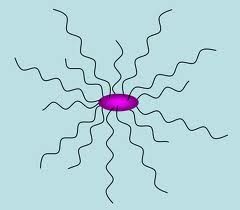
Having flagella uniformly distributed all over the body
|
|
|
What is amphitrichous?
|
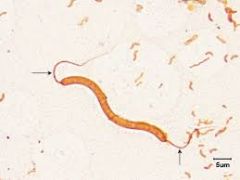
Having flagella at both ends.
|
|
|
What is monotrichous?
|
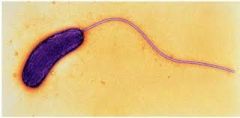
Having flagellum at one pole (end) only.
|
|
|
What is lophotrichous?
|
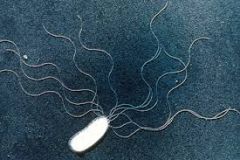
Having a tuft of flagella at one end.
|
|
|
What are fimbriae and pili (pl)/pilus(sl)?
|
Small hair-like projections
|
|
|
What are the functions of fimbriae and/or pili/pilus?
|
1) SEXUAL CONJUGATION--pili form tubes for transfer of genetic material.
2) Surface ADHESION 3) BACTERIOPHAGE receptors--some viruses attach to pili |
|
|
What are the three functions of a cell wall (lattice/net-like structure)?
|
1) Maintains the shape of the cell
2) Physical protection 3) Enables the cell to escape rupture (lysis) in a HYPOTONIC environment |
|
|
What does the cell wall consist of?
|
Peptidoglycan units that repeat over and over
|
|
|
Gram POSITIVE cell walls contain?
|
Many layers of peptidoglycan. Forms a thick rigid structure. Contains TEICHOIC ACID.
|
|
|
Gram NEGATIVE cell walls contain?
|
Thin layer of peptidoglycan. Looser lattice (less rigid cell wall). High lipid content. NO TEICHOIC ACID.
|
|
|
What are the functions of the plasma membrane?
|
1) Regulates diffusion in/out of the cell
2) Contains active transport system 3) Site of enzymes involved in ATP production |
|
|
What model is the plasma membrane also known as?
|
"Fluid Mosaic Model" Phospholipid bilayer. A "dynamic" arrangement of phospholipids and proteins
|
|
|
What do chromatophores contain?
|
CHLOROPHYLL--only found in photosynthetic bacteria
|
|
|
Is the nuclear material of prokaryotic cells contained in a nucleus?
|
No. Chromosome (DNA) loose in the cytoplasm in the nucleoid region
|
|
|
What are plasmids?
|
Small, circular, double-stranded DNA molecules
|
|
|
What are ribosomes?
|
Granules scattered throughout the cytoplasm
|
|
|
What is protein synthesis?
|
Assembling of amino acids into polypeptides
|
|
|
What are cytoplasmic inclusions?
|
Accumulated store materials:
1) Metachromatic granules (Volutin) 2)Polysaccharide granules 3) Lipid inclusions |
|
|
Metachromatic granules (Volutin) is a stored form of what?
|
Phosphate. Metachromatic granules readily take up stains
|
|
|
What are magnetosomes?
|
Inclusions of iron oxide. Act like magnets. May protect cells from accumulation of hydrogen peroxide
|
|
|
What is an endospore?
|
A highly resistant structure produced by bacteria.
Highly resistant to desiccation, heat, toxic chemicals (calcium and dipicolinic acid). Low metabolic activity (dormant). Low H2O content. Thick spore coat. |
|
|
All members of what family produce endospores?
|
Bacillaceae
Ex: Genus Bacillus and Clostridium |
|
|
Is the formation of endospores a reproductive process?
|
No. Vegetative (metabolically active) cell forms a single spore.
Germinates to form one vegetative (metabolically active) cell |
|
|
What is unique about eukaryotic cells when compared to prokaryotic cells?
|
Eukaryotic cells have a true nucleus containing genetic material.
Contain membrane bound organelles |
|
|
What is a cytoskeleton?
|
A network of fibers that form a dynamic framework for support and movement
|
|
|
What are the different types of filaments do eurkaryotic cells have?
|
Microfilaments, actin filaments, intermediate filaments
|
|
|
Which kingdoms are classified as eurkaryotic?
|
PROTISTA, Plantae, Fungi, Animalia
|
|
|
What do MICROTUBULES form?
|
Microtubules form cilia, flagella, and centrioles
|
|
|
What are organelles?
|
Specialized structures that perform specific functions. They can also sequester reactions.
|
|
|
How do organelles increase their surface area?
|
They contain folded membranes
|
|
|
This organelle is spherical or oval and contains the cell's DNA.
|
Nucleus
|
|
|
This structure has a double membrane perforated by pores. It maintains nuclear shape and regulates transport in/out of the nucleus.
|
Nuclear Envelope/Membrane
|
|
|
These are one or more spherical bodies within the nuclear envelope and functions in the synthesis of RIBOSOMAL RNA
|
Nucleolus
|
|
|
This organelle is studded with ribosomes and is the site of synthesis of secretory proteins and membrane molecules
|
ROUGH Endoplasmic Reticulum (ER)
|
|
|
This structure lack ribosomes. It synthesizes phosolipids, fats and steriods
|
Smooth ER (Endoplasmic Reticulum)
|
|
|
These two structures together are involved in the synthesis of macromolecules
|
Rough and Smooth ER
|
|
|
These are formed of 2 subunits: 60S and 40S
|
Ribosomes
|
|
|
Where are free ribosomes found?
|
Suspended in the cytoplasm
|
|
|
Where are bound ribosomes found?
|
Attached to the ER (rough)
|
|
|
Ribosomes are involved with the synthesis of what?
|
Proteins
|
|
|
What apparatus/organelle modifies macromolecules?
|
Golgi Apparatus
|
|
|
The Golgi Apparatus are compose of flattened sacs that are stacked on one another. What are the functions of the this organelle?
|
It receives and modifies products from the ER. It packages products in vesicles for: transport, secretory, and storage.
|
|
|
These are membrane-enclosed sac of HYDROLYTIC enzymes (for catabolism). It functions in phagocytosis, recycles cell's own organic material, and programmed cell destruction (apotosis)
|
Lysosomes
|
|
|
Excess lipid accumulation that damages brain cells is known as what type of disease?
|
Tay-Sachs disease
|
|
|
Tay-Sachs disease (a lysosomal storage disease) is a result of what?
|
Lysosomes lacking one of the hydrolytic enzymes to break down excess lipid
|
|
|
The "power house of the cell"
|
Mitochondria
|
|
|
The inner membranes of the mitochondria folds to form what is known as?
|
Cristae
|
|
|
Where are the sites of cellular respiration (ATP production) in the mitochondria?
|
Cristae
|
|
|
This important structure is semipermeable and selectively permeable. It controls what enters/exits. Maintains cell's homeostasis. It keeps the internal chemical composition within narrow limits
|
Plasma Membrane
|
|
|
The movement of materials across the plasma membrane is known as?
|
Transport
|
|
|
This type of transport does not require energy from the cell
|
Passive transport. [Diffusion = passive]
|
|
|
What is simple diffusion?
|
Molecules move from an area of greater concentration to an area of lesser concentration
|
|
|
When a carrier protein combines with a specific substance and moves it across the membrane is known as?
|
Facilitated diffusion. Can be specific and nonspecific
|
|
|
The diffusion of water through a semipermeable membrane, from higher concentration to lower concentration is known as?
|
Osmosis
|
|
|
What is osmoregulation?
|
The control of water balance
|
|
|
What is an isotonic solution?
|
Concentration of dissolved substances are the same inside and outside the cell. No net flow of water.
|
|
|
What is a hypertonic solution?
|
High solute concentration. Water will move towards an area of higher solute concentration.
|
|
|
What is a hypotonic solution?
|
Low solute concentration. Water will move from an area of HIGH solute concentration to an area of LOW solute concentration
|
|
|
What is plasmoptysis?
|
Bursting of a cell in a hypotonic solution (osmotic lysis)
|
|
|
What is plasmolysis?
|
Shrinkage of the cytoplasm due to loss of water in a hypertonic solution
|
|
|
What are channel proteins?
|
Proteins which form channels through the membrane allowing passage of certain molecules
|
|
|
What are gated channels?
|
Protein channels that open/close
|
|
|
What can active transport do?
|
It can move substances against their concentration gradient. Requires energy (ATP). EX: sodium-potassium pump.
|
|
|
How are large proteins transported?
|
Endocytosis
|
|
|
What 3 types of endocytosis?
|
1) Phagocytosis (cell eating)--pathogen is enclosed in membrane-bound vesicle
2) Pinocytosis (cell drinking)--pathogen is enclosed in membrane-bound vesicle 3) Receptor-Mediated Endocytosis--how most human virsuses get into cell |
|
|
When vacuole fuses with plasma membrane and expels contents from cell is known as?
|
Exocytosis
|
|
|
Who was the first to use porcelain filters to remove bacteria?
|
Charles Chamberland
|
|
|
What did Dmitri Ivanovsky discover?
|
Some filtrates (after using porcelain filters) were still infectious
|
|
|
The term "Contagium vivium fluidium" (Contagious living fluid) was coined by who?
|
Martinus Beijerrinck. Later coined the name virus (meaning poison or venom)
|
|
|
What did Wendell Stanley do?
|
Crystallized the first virus (TMV). Consisted of protein and RNA. Viruses first observed with an electron microscope
|
|
|
Who came up with the concept that certain inherited traits seem to be passed from parent to offspring as discrete hereditary "particles."
|
Gregor Mendel (Mendel's Particles)
|
|
|
Which two concluded that genetic material of some viruses was DNA?
|
Hershey and Chase
|
|
|
Can the nucleic acid be both DNA and RNA at the same time?
|
No. It's either DNA or RNA. Never both
|
|
|
What is the protein coat that surrounds the nucleic acid in viruses called?
|
Capsid--made by virus protein; not human protein.
**Capsid and capsule are not the same thing** |
|
|
What the protein subunits in viruses called?
|
Capsomeres
|
|
|
When a virus stimulates antibody production, what is called?
|
Antigenic/Immunogenic
|
|
|
Some proteins have a/an __________ around the protein coat.
|
envelope
|
|
|
What does a virus need to multiply?
|
A host cell.
1) Viruses multiply in living cells--they cannot synthesize proteins or generate ATP) 2) Viruses take over the metabolic activity of host cells--as a result, it is difficult to disrupt viral replication without interfering with host cell functions |
|
|
Most viruses can only be visualized with what?
|
An electron microscope
|
|
|
What are some typical shapes of viruses?
|
Helical, spiral, icosahedral (20 sided polyhedron), envolped, complex
|
|
|
What can HEAT do to viruses?
|
Most are destoyed by >60C, 140F
|
|
|
What can extreme cold do to viruses?
|
Not much. Most can survive -76C for over a year
|
|
|
Can viruses tolerate desiccation?
|
Yes. Some viruses can tolerate drying
|
|
|
At which pH range can viruses tolerate?
|
Around 5-9 pH
|
|
|
Are disinfectants effective antiviral agents?
|
No. Most disinfectants are infective. Alcohol can destroy lipid envelope viruses
|
|
|
What are the most effective agents against viruses?
|
Oxidzing agents: Hydrogen peroxide, chlorine, iodine, UV light damages nucleic acid
|
|
|
What are four ways to cultivate viruses?
|
1) Living animals and plants
2) Embryonated eggs--virus is injected into embryonic tissues and membranes 3) Tissue/Cell Culture--cells in solution that provides: nutrients, proper osmotic pressure, pH, etc 4) Bacterial culture |
|
|
Of the four methods to cultivate bacteria, which is the easiest and most economical?
|
Bacterial culture
**Limitation: only viruses that are specific for bacteria (phage) |
|
|
How long can viruses be cultivated in Primary cell and embryonic diploid cell lines?
|
For a short period of time--can only divide so much (Hayflick limit).
|
|
|
How long can viruses be cultivated in Continuous/Immortal cell lines?
|
They can be maintained in vitro (glass) indefinitely. HeLa cell line--made possible by Henrietta Lacks
|
|
|
List the 5 stages/steps of T-even Bacteriophage Lytic Cycle
|
1) Attachment/Adsorption
2) Penetration 3) Biosynthesis 4) Maturation/Assembly 5) Release/Lysis |
|
|
What happens during the attachment/adsorption step of the T-even Bacteriophage Lytic Cycle?
|
Phage tail fibers attach to specific receptors on bacteria.
|
|
|
What happens during the penetration step of the T-even Bacteriophage Lytic Cycle?
|
Phage release enzyme --> lysosome dissolves part of the bacterial cell wall.
|
|
|
What happens during the biosynthesis step of the T-even Bacteriophage Lytic Cycle?
|
Viral DNA takes over the machinery of the host cell and begins producing viral DNA and structural components
|
|
|
What happens during the maturation/assembly step of the T-even Bacteriophage Lytic Cycle?
|
Phage DNA assembles into complete viruses
|
|
|
What happens during the release/lysis step of the T-even Bacteriophage Lytic Cycle?
|
Phage lyzosome breaks down bacterial cell wall and multiplied phages are released. Viron is fully ready to infect again
|
|
|
What is burst time?
|
The time from adsorption of virus to its release (in minutes)
|
|
|
What is burst size?
|
The average number of virons released by a cell (50-200 virons for T-even phage)
|
|
|
What is lysogeny?
|
Viral DNA is incorporated into the host DNA without causing lysis of the host cell
|
|
|
What is a lysogenic cell?
|
A cell containing a prohage (provirus--human/animal)
|
|
|
What are prophage genes repressed by?
|
Repressor proteins
|
|
|
What is latency with regards to viruses?
|
The ability to remain in host cells for long periods
|
|
|
What is meant by phage conversion?
|
The host cell carrying a lysogenic phage which may exhibit new properties
|
|
|
What is meant by induction/excision?
|
Certain environmental factors may cause a prophage to revert to the lytic cycle. EX: UV light or certain chemicals.
|
|
|
What is specialized transduction?
|
When a prophage is excised from the host chromosome it can take with it adjacent DNA from the bacterial chromosome
|
|
|
When compared to prophage, animal viruses differ in which steps of their cycles?
|
* Attachment
* Penetration occurs by receptor-mediated endocytosis * Uncoating by viral or host cell enzymes Biosynthesis *Maturation and release (Budding) |
|
|
What is it called when a virus remains in asymptomatic host cell for long periods (Lysogeny)?
|
Latent viral infections
|
|
|
Latent viral infections can be reactivated by what?
|
Fever, UV light, stress, trauma, hormaonal changes and repair mechanisms in the cell. EX: cold sores, shingles
|
|
|
Which two found that leukemia could be transferred to healthy chickens by cell-free filtrates containing viruses?
|
Wilhelm Ellerman and Olaf Bang
|
|
|
Who discovered that chicken sarcoma was similarly transmitted as discovered by Wilhelm Ellerman and Olaf Bang?
|
F. Peyton Rous
|
|
|
Genes that can cause a normal cell to be transformed into a malignant cell are known as?
|
Oncogenes
|
|
|
Which two Noble prize winners discovered that cancer-inducing genes carried by viruses are derived from the animal cell genome?
|
Michael Bishop and Harold Varmus
|
|
|
What are proto-oncogenese?
|
They normally direct synthesis of products for cell growth and development. When a virus contain an oncogene is introduced into a cell, the cell may be unable to regulate synthesis of the virus's oncogene. the excess product may result in uncontrolled cell division
Proto-oncogenes can become an oncogene due to mutations or increased |
|
|
What are prions and who received the Noble Prize in Medicine for is work on prions?
|
Prions are proteinaceous infectious particle. Stanley Prusiner
|
|
|
How can infectious proteins be transmitted?
|
Inherited and transmitted by: ingestion, transplant, surgical instruments
|
|
|
What are some diseases/disorders associated with Spongiform encephalopathy?
|
Sheep scrapie, Creutzfeldt-Jakob disease, Gerstmann-Straussler-Scheinker syndrome, fatal familial insominia, mad cow disease
|
|
|
What are some characteristics of prions that make them so dangerous?
|
1) Resistant to heating
2) No sensitive to radiation treatment 3) Not destroyed by enzymes that digest DNA or RNA 4) Not sensitive to protein denaturing agents such as phenol 5) Shown to easily move from one species to another |
|
|
What is PrPc?
|
Normal cellular prion protein on cell surface--well all have and need
|
|
|
What is PrPsc?
|
Scrapie protein is believed to result from a mutation in a normal gene for PrPc or contact with the harmful altered/harmful form converts the normal protein into harmful form
|
|
|
What results when harmful the PrPsc form accumulates in brain cells?
|
Plaques
|
|
|
What are antibiotics?
|
Anitmicrobial substances produced by microorganisms
|
|
|
What are the 5 major genera of antibiotics?
|
1) Penicillium (fungi)
2) Cephalosporium (fungi) 3) Streptomyces (Actinomycetes) 4) Micromonospora (Actinomycetes) 5) Bacillus (Gram + Bacteria) |
|
|
What does a bacteriostatic do?
|
Inhibits the growth of bacteria but does not kill them
|
|
|
What does a bactericidal do?
|
It kills bacteria
|
|
|
What is a narrow spectrum antibiotic?
|
Affect only a select group of microbes.
|
|
|
What is a broad spectrum antibiotic?
|
Affect large numbers of bacteria (Gram +/-) and normal flora as well
|
|
|
What is a superinfection?
|
An overgrowth by a resistant organism?
|
|
|
What are the modes of actions of antibiotics?
|
1) Inhibition of cell wall synthesis (doesn't apply to us)
2) Inhibition of Protein synthesis 3) Injury to plasma membrane 4) Inhibition of nucleic acid synthesis 5) Inhibition of the synthesis of essential metabolites |
|
|
What are the 4 mechanisms of RESISTANCE by bacteria for antibiotics?
|
1) Ability to destroy the antimicrobial
2) Prevent penetration of the antimicrobial 3) Alteration of target structure 4) Active transport (EFFLUX pumps)--pumps antimicrobial against its concentration gradient |
|
|
What are 4 ways we can control resistance of bacteria for antibiotics?
|
1) Administer effective dose and finish the complete dosage
2) Avoid using outdated, weakened antibiotics 3) Eliminate indiscriminate use 4) COMBINE THERAPY--two or more antibiotics given simultaneously --> Combine an antibiotic with a B-lactamase inhibitor |
|
|
What is the term for when antibiotics increase the activity of one another? EX: Penicillin and Streptomycin
|
Synergistic
|
|
|
What is the term for when antibiotics knock each other out (compete against one another)? EX: Penicillin and Tetracycline
|
Antagonistic
|
|
|
What is special about Augmentin?
|
Amoxicillin combined with Potassium clavulanate (a B-lactamase inhibitor)
|
|
|
The sum of all chemical reactions that occur within a living organism is known as?
|
Metabolism
|
|
|
The synthesis of chemical compounds--combine simpler substances into more complex molecules, is known as?
|
Anabolism--requires energy (endergonic). EX: protein from amino acids
|
|
|
What is catabolism?
|
The break down of complex compounds into simpler ones--releases energy (exergonic)
|
|
|
What are enzymes?
|
Biological catalysts--binds to substrates at active site. Specialized proteins that speeds up a reaction without being altered by the reaction
|
|
|
What does an enzyme lower?
|
The activation energy of reactions.
|
|
|
What gives enzymes their specificity?
|
Active sites on the enzyme
|
|
|
What is the complex called when an enzyme binds with a substrate?
|
Enzyme-substrate complex--some enzymes are protein only, other have a protein and nonprotein cofactor
|
|
|
What does an enzyme regulate when it binds to the substrate?
|
1) Physical shape
2) ionic character |
|
|
What is the protein portion on the enzyme called?
|
Apoenzyme
|
|
|
Cofactors for enzymes are?
|
the nonprotein component (can be metallic).
**Coenzyme: organic cofactor |
|
|
Apoenzyme + cofactor = ?
|
Holoenzyme--whole functional enzyme
|
|
|
Lock and key fit of substrate and enzyme means what?
|
Enzymes only react with a specific substrate. Specificity is due to surface configuration/conformation (shape) of the protein
**Conformation is the result of: primary, secondary, tertiary and quaternary structures |
|
|
What are the weak interactions that enzymes together?
|
1) Hydrogen bonding
2) Ionic bonding 3) Hydrophobic Interactions (nonpolar R groups) |
|
|
Bridges between two cysteine monomers is a what type of bond?
|
Disulfide bond--covalent linkage
|
|
|
What are the 5 factors that influence enzyme activity?
|
1) Denaturing by temperature and pH
2) Substrate concentration 3) Competitive inhibition 4) Noncompetitive inhibition (Allosteric--another site) 5) Feedback inhibition |
|
|
Explain the effects of temperature on enzyme activity.
|
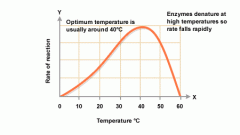
Enzymatic activity increases with increasing temperature until the enzyme, a protein, is denatured by heat and inactivated. At this point, the reaction rate falls steeply
|
|
|
Explain the effects of pH on enzyme activity
|
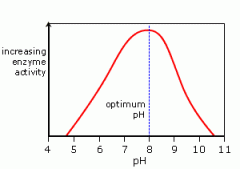
The enzyme illustrated is most active at about pH 8.0
|
|
|
Explain the effects of substrate concentration on enzyme activity
|
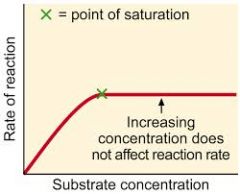
With increasing concentration of substrate molecules, the rate of reaction increases until the active sites on all the enzyme molecules are filled, at which point the maximum rate of reaction is reached.
|
|
|
Where do exoenzyme/extracellular enzymes function?
|
Outside of cell
|
|
|
Where do endoenzymes/intracellular enzymes function?
|
Inside of cell
|
|
|
What is genetics?
|
The science of heredity. The study of genes: how they carry information, pass that info on and how is that info expressed
|
|
|
What are the functional units of heredity?
|
Genes--contain the info (codes) for inherited characteristics: morphology, metabolism, behavior, pathology, etc
|
|
|
What is genotype?
|
The genetic makeup of an organism--the information itself, expressed or not.
|
|
|
The total of all genes (genetic information) in a cell is a?
|
Genome
|
|
|
The physical/external manifestation of the genotype is called?
|
Phenotype--physical traits or appearance
|
|
|
Genes consist of what?
|
Segments of DNA
|
|
|
What is DNA
|
Deoxyribonucleic acid. Nucleic acid (repeating units called nucleotides. Three basic components:
Bases: Adenine, Thymine, Guanine, Cytosine Sugar: Deoxyribose Phosphate: Backbone |
|
|
In eukaryotic cells, what is DNA wound around?
|
Clusters of HISTONES (chromosomal proteins)
|
|
|
How are the 2 strands of DNA arranged in DNA?
|
2 ANTIPARALLEL strands joined by HYDROGEN BONDS
|
|
|
During DNA replication, what happens to DNA's double helix structure?
|
It is unwound by enzymes
|
|
|
What adds new bases to the new DNA strand?
|
DNA Polymerase
|
|
|
What is meant by SEMICONSERVATIVE with regards to DNA replication?
|
When DNA replication is complete, there is one new strand and one original strand that are joined together.
|
|
|
What are RNA sugars made up of?
|
Ribose
|
|
|
What is the central Dogma of modern biology?
|
DNA---------(transcription)----->mRNA--------(translation)------->Protein (Proteins originate from DNA)
|
|
|
The process of synthesizing mRNA from a DNA template is known as what?
|
Transcription
|
|
|
Transcription involves/requires what?
|
RNA Polymerase binding to a promoter. Uracil is substituted for Thymine
|
|
|
In eukaryotic cells, what processing step is needed to have a functional mRNA after transcription?
|
Remove of INTRONS and EXONS are joined together with a CAP and TAIL and then exits the nucleus
|
|
|
The process of using an mRNA template for protein synthesis is known as what?
|
Translation
|
|
|
What is a codon?
|
A set of 3 bases on an mRNA. Each codon specifies a specific amino acid.
|
|
|
What are the 3 steps in Translation?
|
1) Initiation--mRNA becomes associated with a ribosome
2) Elongation--a series of Transfer RNAs (tRNA) each with a specific amino acid attaches to mRNA in the ribosome 3) Termination/Stop--a termination or stop codon/signal attaches and the ribosome, mRNA and protein separate |
|
|
What type of bonds form between amino acids?
|
Peptide bonds
|
|
|
What carries the ANTICODON and the amino acid?
|
tRNA
|
|
|
Who worked with two strains of Strep. pneumoniae and discovered genetic transfer?
|
Frederick Griffith:
Heat Killed Virulent (with capsules) + Live Avirulent (no capsules) ----> Live Virulent (with capsules) |
|
|
What is TRANSFORMATION?
|
The process in which genes are transferred from one bacterial cell to another as "naked" DNA in solution
|
|
|
What is the mechanism of transformation of genes in bacteria?
|
Fragments of DNA from lysed cells are take up by other bacteria and recombine with their own DNA
|
|
|
The transfer of genetic information by cell to cell contact is known as what?
|
CONJUGATION (via pilus):
Donor (F+) cell attaches to recipient (F-) cells by means of sex pili and transfer genetic material. Can transfer plasmids or parts of its own chromosome |
|
|
The transfer of genetic information from one bacteria to another by means of a bacteriophage is known as what?
|
TRANSDUCTION
|
|
|
What is a bacteriophate?
|
A virus that infects bacteria
|
|
|
Small, self-replication circles of DNA found in many bacteria are called?
|
Plasmids
|
|
|
What is an F Plasmid?
|
Fertility Plasmid--bacterium carrying the fertility factor transfers the gene(s) coding for the factor to a bacterium lacking it by CONJUGATION
|
|
|
What does a CONJUGATIVE plasmid carry?
|
It carries genes for sex pili and transfer of the plasmid
|
|
|
What do Dissimilation plasmids encode for?
|
They encode enzymes for the catabolism of unusual compounds.
EX: Some Pseudomonas can metabolize toluene, camphor and petroleum hydrocarbons--possible use in BIOREMEDIATION |
|
|
What does R Plasmids (resistance factors) provide?
|
Provide resistance to antibiotics and other chemicals--has a gene that provides that particular resistance
|
|
|
Can there be plasmids for toxin production?
|
Yes. EX: Tetanospasmin Staphylococcal entertoxin
|
|
|
True or False: Genes for several traits may be coupled together on the same plasmid.
|
True
|
|
|
What are TRANSPOSONS (Jumping Genes)?
|
Segments of DNA that can move their position in the genome
|
|
|
Who discovered TRANSPOSONS (Jumping Genes) but wasn't fully recognized for it at the time?
|
Barbara McClintok
|
|
|
What do transposons contain?
|
Insertion sequences that code for an enzyme for cutting and resealing DNA (Transposase)
Complex transposons carry other genes in addition to transposase genes |
|
|
Any alteration in the base pair sequence is known as what?
|
Mutations
Mutations in gametes can be passed onto offspring Bacteria does not have gametes, any mutation(s) get passed on |
|
|
What are spontaneous mutations?
|
They are the results of mistakes in replication or natural background radiation.
1 mutation per 10^5 - 10^6 replications |
|
|
What are induced mutations?
|
Mutations that are caused by mutagens/mutagenic agents such as X-rays, carcinogens, nucleoside analogs
|
|
|
What is a POINT mutation?
|
Base pair substitutions--alteration in a single base
|
|
|
What are three types of point mutations?
|
1) Same-sense mutation
2) Mis-sense mutation 3) Nonsense mutation |
|
|
What is same-sense mutation?
|
It's a point mutation in which the mutation codes for the SAME amino acid
|
|
|
What is mis-sense mutation?
|
It's a point mutation which codes for a DIFFERENT amino acid altogether
EX: Sickle Cell Anemia--CTT = Glutamic acid changed to CAT = Valine |
|
|
What is a nonsense mutation?
|
It's a point mutation that codes for a "stop" signal or a stop signal is substituted with an amino acid
|
|
|
Insertions or Deletions are what types of mutations?
|
FRAME SHIFT MUTATION
EX: Deletion THE CATE ATE THE RAT THC ATA TET HER AT |
|
|
These types of enzymes are produced constantly (present at all times), not subject to repression--"has no off button"
|
Constitutive Enzymes
***Other enzymes are expressed only as needed*** |
|
|
What are repressive enzymes?
|
These enzymes are subject to repression--can be shut off
|
|
|
These enzymes are only produced when needed.
|
Inducible enzymes
|
|
|
What type of gene codes for a repressor protein?
|
Regulatory gene
|
|
|
What is the site of RNA polymerase attachment called?
|
Promoter
|
|
|
This gene acts as a switch. Controls transcription of the structural gene.
|
Operator
|
|
|
What gene codes for the amino acid sequence of a protein?
|
Structural gene
|
|
|
This operon is normally in the "on" mode but is turned off when the gene product is in abundance
|
Repressible operon
***The gene product acts as a COREPRESSOR. The corepressor activates the repressor |
|
|
What is biotechnology?
|
The use of microorganisms, cells or cell components to make a product. EX: foods, antibiotics, vitamins, enzymes
|
|
|
The manipulation of genetic material for practical purposes is known as?
|
Genetic engineering
|
|
|
Breeding/culturing a naturally-occurring organism/microbe that produces desired product(s) is known as?
|
Artificial selection
|
|
|
What is SITE-DIRECTED mutagenesis?
|
Changes a specific DNA code to change a protein
|
|
|
What is RECOMBINANT DNA technology?
|
Techniques for recombining genes from different sources in vitro and transferring this recombinant DNA into a cell where it may be expressed
***This allows for genes to be moved across species barriers*** |
|
|
What are the NATURAL BARRIERS that recombinant DNA technology can overcome?
|
Anatomical, molecular, physical appearance, behavioral, molecular
|
|
|
What are RESTRICTION enzymes and what makes them special?
|
Discovered in bacteria
Destroy bacteriophage DNA and DNA picked up in transformation in bacterial cells (can order to specificity--catalogs) Cannot digest (host) DNA because of methylated cytosines Recognize short, specific nucleotide sequence |
|
|
What recoginition sequnces?
|
"Symmetrical" sequences 4-8 necleotides running in opposite directions
|
|
|
What is a palindrome sequence?
|
A sequence that reads the same forward and backward.
GAATTC on one strand and CTTAAG CTTAAG GAACCT Restriction enzymes cut between the same adjacent nucleotides on both strands |
|
|
What are RESTRICTION fragments?
|
Double-stranded DNA (that has been cut with a Restriction enzyme) with single-stranded ends ("Sticky ends")
|
|
|
What are the "Sticky ends" used for?
|
To join DNA from different sources
|
|
|
Are the union of "sticky ends" temporary or permanent?
|
Temporary when held together by HYDROGEN BONDS
Permanent when DNA ligase is added |
|
|
What is the outcome of restriction fragments joining together?
|
A DNA molecule carrying a new combination of genes
|
|
|
What is gel electrophoresis?
|
This method separates molecules based on size and electrical charge
Used to separate restriction fragments Isolate and purify individual fragments Band patterns used in DNA fingerprinting |
|
|
Vectors can do what?
|
Carry new DNA to desired cell
|
|
|
What is special about a shuttle vector?
|
It can move cloned DNA among several different species
|
|
|
What can be used as vectors?
|
Pasmids and viruses (recombined DNA molecules are useful only if they can be made to replicate)
|
|
|
What are gene libraries?
|
Gene libraries are made of pieces of an entire genome stored in plasmids or phages
|
|
|
cDNA (complimentary DNA) is made from mRNA by?
|
Reverse transcriptase
|
|
|
What are some ways in which DNA can be inserted into a cell?
|
Transformation, Electroporation (with electric pulsation), protoplast fusion, microinjection, gene gun
|
|
|
What does PCR (Polymerase Chain Reaction) do?
|
Amplifies DNA
Extremely small samples of DNA can be multiplied to high concentration |
|
|
What is PCR used for?
|
Clone DNA for recombination
Amplify DNA to detectable levels Sequence DNA Diagnose genetic disease Detect pathogens |
|
|
What is unique about RFLP Analysis (Restriction Fragment Length Polymorphism)?
|
Each person has a unique arrary of RFLPs--"genetic fingerprint"
Forensic use: about 1 in a million chance two people will have matching DNA fingerprints for the few regions tested |
|
|
What are subunit/piggyback vaccines?
|
An application of genetic engineering are nonpathogenic viruses carrying genes for pathogen's antigens as vaccines
|
|
|
What is genetic screening?
|
Application of genetic engineering use to diagnose genetic disorders
|
|
|
What is gene therapy?
|
Application of genetic engineering to replace defective or missing genes
|
|
|
What is Antisense RNA?
|
Application of genetic engineering. Complementary to normal RNA. Blocks mRNA from directing protein synthesis
|
|
|
What are DNA probes?
|
Application of genetic engineering. Used to detect and identify pathogens in food and patients
|

